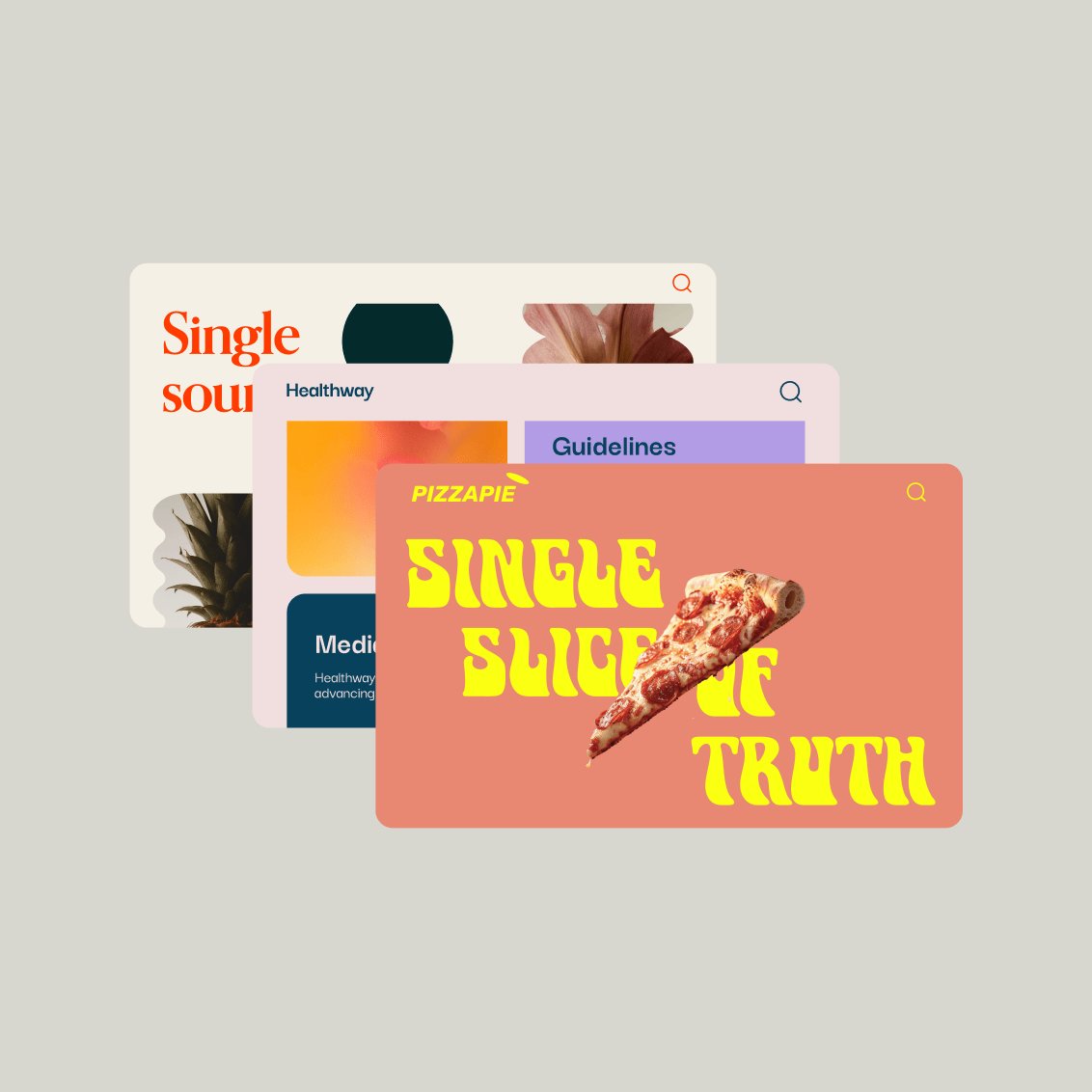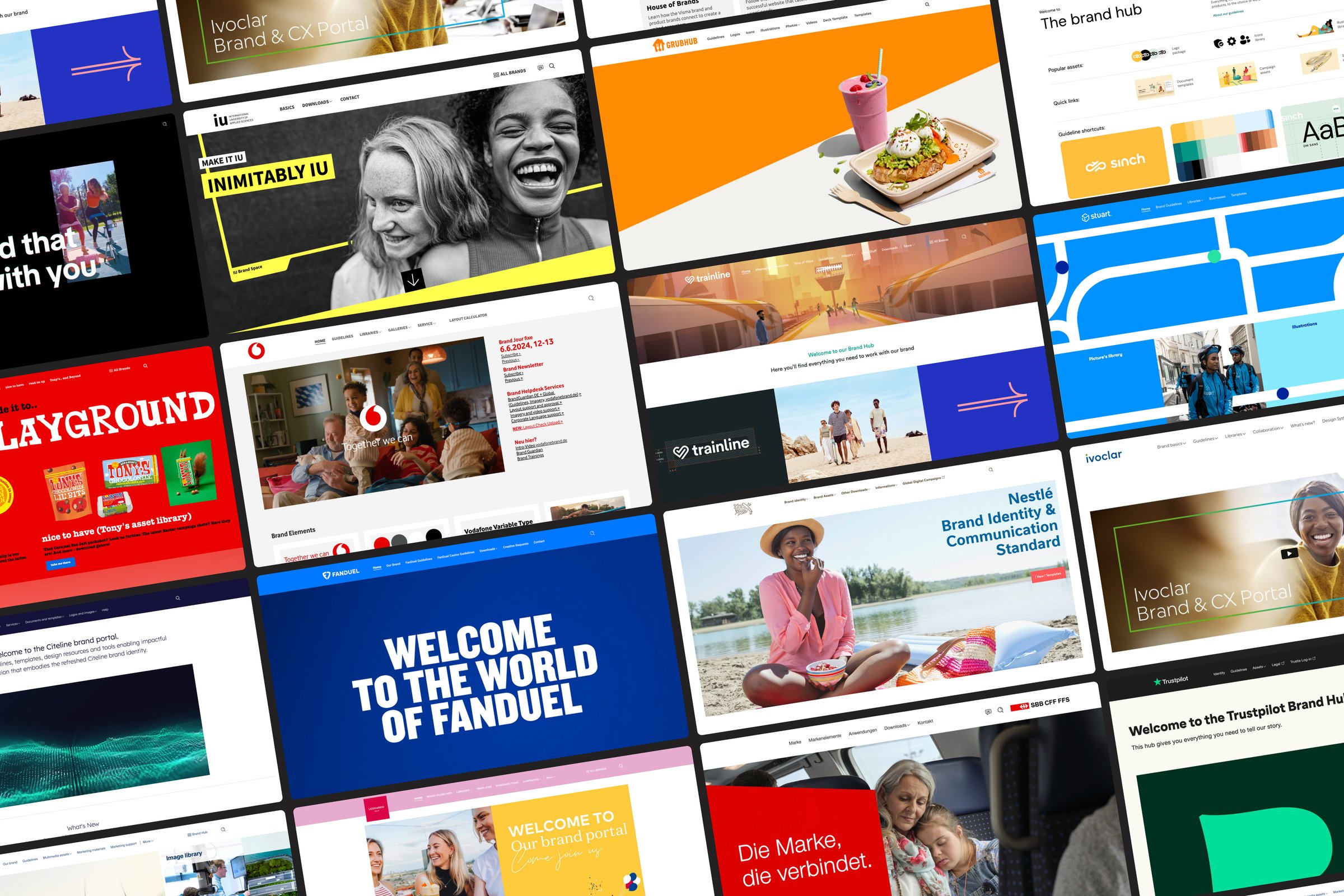Key takeaways
- Great brands don't happen by accident—they're built through consistent, accessible guidelines that evolve with your story and become second nature for your entire team.
- Your brand guide (whether you call it a brand book, manual, or style guide) is the north star that helps everyone—from new hires to longtime partners—speak your brand's language authentically.
- The most powerful guidelines bring together all the elements that make you uniquely you: your core values, logo standards, signature colors, visual storytelling approach, and the distinctive voice that makes conversations with your brand feel human.
- Digital platforms like Frontify make your brand guidelines more than a document—they become a living resource everyone can access, embrace, and apply effortlessly.
The current state of brand guidelines

To build a strong, recognizable brand, you need everyone in your business to present a consistent brand identity to your customers and the market. But our State of Brand Ownership Report found that the worst offenders when creating off-brand materials were the teams you’d expect to be most invested: C-level executives and marketing departments.
But that’s not all: In the report, we found that 67% of respondents use creative guidelines that aren’t part of their official brand guidelines. This suggests that two-thirds of companies have guidelines that aren’t being used properly by their employees, potentially leading to inconsistent messages, confused customers, and weakened brand identity.
Developing comprehensive guidelines is a start. But companies also need to make the information accessible, update it regularly, and ensure that teams follow the guidelines whenever they create assets.
What are brand guidelines?

Brand guidelines document and share the rules, standards, and instructions for bringing your brand to life. They help teams achieve consistency by detailing how your brand should look, act, and sound. They include your company’s mission statement and core values and explain how to use visual and written elements to express your brand identity in your content.
Many companies initially document their brand guidelines in PDFs. However, as the business grows and its brand evolves, employees find it hard to maintain and update the files to ensure everyone is working from the latest version.
When branding becomes a priority, companies often switch to an online platform to host their guidelines instead. Because online guidelines are a centralized home for your brand, any changes are automatically reflected for all employees, so everyone always has access to the latest information.
What are the benefits of brand guidelines?

Guidelines help engage people with your brand by defining and documenting what your brand means. They turn “brand” from an abstract concept into something concrete that each team and employee can understand and apply in their daily work. Brand guidelines are important because they:
- Boost internal engagement: Everyone on your team can access and use your brand guidelines, not just your creative teams. This gives all employees a greater sense of ownership and the ability to create on-brand messages, designs, and customer experiences independently.
- Improve consistency: Guidelines explain how to use different elements of your brand identity to produce content that reflects that essence. Providing the same guidelines to internal teams, external partners, agencies, and freelancers ensures consistent materials.
- Build brand recognition: Consistency across visuals, voice, and behavior make your brand look professional and help your audience recognize your brand.
Brand guidelines align your entire company with your brand’s values, style, and messaging. They’re where all your employees and external partners learn how to communicate to present an authentic brand to your customers.
What should you include in your brand guidelines?
Brand core
The brand core is the foundation on which a brand is built, encapsulating its heart and soul. It's not just about what a company does or sells but why it exists. This identity is pivotal in guiding decision-making, shaping brand experiences, and aligning with the audience's values and expectations. Let's delve into the components of the brand core.
Brand values: These are the non-negotiable principles that define the ethical and operational backbone of the brand. Brand values guide behavior, decisions, and actions, ensuring that every aspect of the brand aligns with these foundational beliefs. They help build trust and loyalty with the audience by consistently showing what the brand stands for.
Mission statement: This concise statement articulates the brand's purpose and reason for being — beyond making a profit. A well-crafted mission statement is inspirational and directs the brand's efforts toward a common goal.
Vision statement: Whereas the mission statement focuses on the present, the vision statement looks to the future, outlining what the brand aspires to become or achieve. It illustrates the brand's long-term aspirations, inspiring and motivating stakeholders to strive toward this shared dream.
In crafting a comprehensive brand core, businesses create a strong, enduring foundation for their brand identity. This foundation not only informs internal strategies and actions but also shapes how the brand is perceived and experienced by the outside world.
Logo use
Your brand guidelines should explain how to use your company logos, covering the following elements:
Color variations: Add the essential color variations, including full color, black, and white, and mention when to use each version.
Logo formats: Include your full logo, text logo or wordmark, single-line, and square versions. Explain when to use which logo, with examples of each format in use.
Logo dos and don’ts: Demonstrate correct logo use on different backgrounds (e.g., plain versus patterned) and channels (e.g., social media versus your website).
For example, Uber’s brand guidelines comprise extensive guidance on logo use, formats, and placement. As an international company, it also explains how to localize its logo in languages that read right-to-left, which is an important consideration as your company scales into new markets.
By using a comprehensive brand-building platform, you enable people to download and share the logos in the same place as they can read about logo usage.

Color palette
Brand colors help build brand recognition and make your company stand out. Covering your color palette in your guidelines is another way to bring consistency to your content and designs.
Add your brand’s color palette, including swatches that illustrate what each color looks like and color codes to use in their design tools. When you add color codes, list them in the relevant formats (like CMYK, HEX, and RGB) so your team uses the correct colors when designing for print and digital.
For example, Frontify’s brand guidelines include our primary, secondary, and gray-scale palettes, with examples showing the colors together. In addition, we made our color swatches downloadable so anyone accessing our guidelines can easily import our brand colors into their design applications. This download capability turns our guidelines from rules and instructions into a practical tool that empowers our employees to engage with our brand in their work.

Imagery
Images show off your products, highlight your customers, and champion your teams. A strong visual identity makes your content stand out in your customers' social feeds, especially if you adopt a different style from your competitors. In the long term, your choice of image style and consistent visuals help build brand recognition.
Your guidelines should include guidance on using images to create designs that communicate your brand identity. Creating on-brand imagery can be challenging for non-designers, so the more guidance and examples you provide, the better. Here’s what your guidelines could cover:
- Image types (e.g., illustrations, photography, iconography, design elements, and patterns)
- Guidance on when to use stock images
- Image categories (e.g., product, industry, company, aspirational, and headshots)
- Preferred color schemes for images

Brand tone of voice
Voice and tone are often forgotten about in guidelines, as many companies focus on the visual aspects of their brand identity. But how you write and speak is just as important for building recognition as your brand’s appearance.
Documenting your brand voice in your guidelines will ensure your written, audio, and video content achieves a consistent voice and style. Tone of voice guidelines help your team adopt a consistent brand voice, regardless of whether it’s a campaign from your marketing team or a ticket response from customer support.
For example, Buffer’s guidelines offer tips on adapting its tone of voice to the customer's needs. Its guidelines list the leading characteristics that make up the brand voice:

How to distribute and manage your brand guidelines
Once your brand guidelines are complete, you need to ensure teams can easily access the latest information.
Share and implement guidelines
Choose digital formats like brand-building platforms or interactive websites for easy access and updates. This approach enhances user engagement and ensures your guidelines remain versatile and relevant. Distribute your guidelines by giving all stakeholders access and providing training and support so that everyone gets the most out of the documentation.
Evaluate feedback and revise
Collect feedback from users to identify areas for improvement. Use this input to revise and update your guidelines regularly, ensuring the information stays relevant and effective. This iterative process maintains your brand's identity.
Frontify helps you create easy-to-use brand guidelines

Some of the world’s leading companies use Frontify’s brand-building platform to house everything related to their brand — including guidelines. With Frontify’s Brand Guidelines, you ensure that everyone has access to up-to-date information that allows them to create, organize, and manage:
- Customize your guidelines with no-code content elements to cover all use cases.
- Share guidelines with your internal team and external agencies and partners, and set access restrictions where necessary.
- Update your guidelines without needing to work with designers or agencies.
- Connect with other areas of the Frontify platform: Our Digital Asset Management (DAM) allows you to store and organize all your brand materials. With our Digital & Print Templates, designers can create editable templates for employees to produce on-brand materials with ease and at scale.
Ready to build your brand guidelines? Request a demo to learn more about the Frontify platform, or start your free trial to see how easy it is to document your brand today.



